Shouldn’t We Upgrade Our Existing Railway Network Instead of Building Bullet Trains?
For all its size, scale and levels of operations, and its excellent IT initiatives, the Indian Railways network is hardly a beacon of technological wonder when it comes to its core operations. It seems to barely hold itself together by the hopes, wishes, and prayers of a billion people and tireless, on-their-toes railway officials. So, as we roll along dreaming about high-speed rail in India, it is only imperative that some time or the other we invariably hit on the most pertinent question on everyone’s mind: What about our existing railway network? How can a state-of-the-art Bullet Train system and a crumbling conventional train network made up of outdated ramshackle trains exist in the same country at the same time? Shouldn’t we improve speed/cleanliness/security/facilities/capacity/ punctuality/ <insert any other shortcoming of our existing railway system> first? In short, shouldn’t we improve/upgrade our existing Indian railways system first before/instead of trying to run Bullet trains?
Of course, we have to improve our existing railway network. However, like we saw in the previous chapter while debating on the “shouldn’t we first develop Indian economically first?” question, “waiting” for our existing network to “become better” before we start running high-speed trains is fallacious. As explained here, most people seem to harbor this pre-conceived notion that change, or “progress” – the incremental development or betterment of any system – has to proceed in a linear this-first-and-then-the-other or “solve this problem/develop this first and then move on to the next” manner. A legacy and hangover of our centrally planned socialist days, this worked fine in yesteryears that history already left behind in the gutters of time, but not today, where the pace and growth of technology fueled by innovation is rendering today’s technology obsolete tomorrow. The only way to stay ahead is to think in advance, far in advance. We simply cannot wait for our existing systems to become flawless before moving on to incremental technology. In this chapter, we will see why we should opt high-speed railways while modernizing our existing railway network at the same time.
The Great Indian High-Speed Rail Dream – Part 4
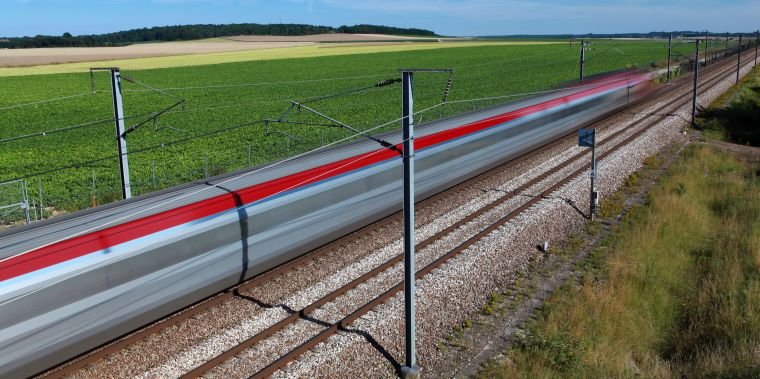
To start with, let us reiterate that high-speed trains are not just fancy-looking vehicles running at high speeds but an entirely new and foreign (or better, alien) super high-technological ecosystem, as or more advanced than airplanes and airports, operating as a system completely separate from our present railways. We are NOT going to run our existing trains at 320 kph on our existing tracks. HSR needs to be developed as a NEW system from scratch with new tracks, routes, and trains of radically different design (Click here to see some of those designs). We Indians are unable to grasp this because we have never seen or experienced such tech. This is also why we try to draw parallels between our present railway systems and “Bullet trains” which have as much in common as an Amazon delivery drone has to an Apache M-64 helicopter gunship, all explained in excruciating detail in this chapter, for those who have missed it. Looking at the way people rant against HSR it would seem that we are going to run the Asansol – Jhajha passenger at 320 kph. A lot of opposition mentality often stems from ignorance, which is true for this particular case as well. Simply put,
Bullet Trains or High Speed Rail is NOT an extension of our current railway system. It is a totally different mode of transport – @krishnagd
And our HSR will be imported, installed and managed (at first) not by us but by those who are already running them successfully in developed countries.
Shouldn’t we Increase Speeds of our Existing Trains First?
Ah, speed. That favorite pet-peeve of every Indian when it comes to Indian Railways (after the toilets). Our trains seemingly are just not fast enough. There are some problems with this most commonly repeated war cry of “make our trains run faster rather than buying/building bullet trains!” Most people think our trains can do supersonic speeds just like how pressing the accelerator will make a car go faster. It is not that simple.
So, how fast should our trains be? There seems to be a consensus that ideally a train journey from Delhi to Kolkata or Mumbai should be completed overnight, or, in 7 or 8 hours. The distance in both these cases is around 1400 km. For a train to cover 1400 km in 8 hours, its average speed has to be 1400/8 = 175 km/h. (Currently, the Rajdhani takes 17 hours at 84 kph average speed to cover this distance). Let us set a benchmark that the average speed of our trains should be 180 kph. But, do note, that we are talking about average speeds and not top speeds. For a train to do an average speeds of 180 kph, its top speeds will have to be around 250 kph. So, why don’t we upgrade something and increase the speeds of the Rajdhani to 250 kph? Unfortunately, no matter what we try, this will not be practically possible.
With our present trains, no matter what how much we strengthen our tracks and automate our signalling, the maximum speed they will ever do is 160 kph. Any train running above 200 kph is classified as a High Speed Train (Bullet Train) and requires special tracks, trains and signaling systems to run. Take a look at this chart.
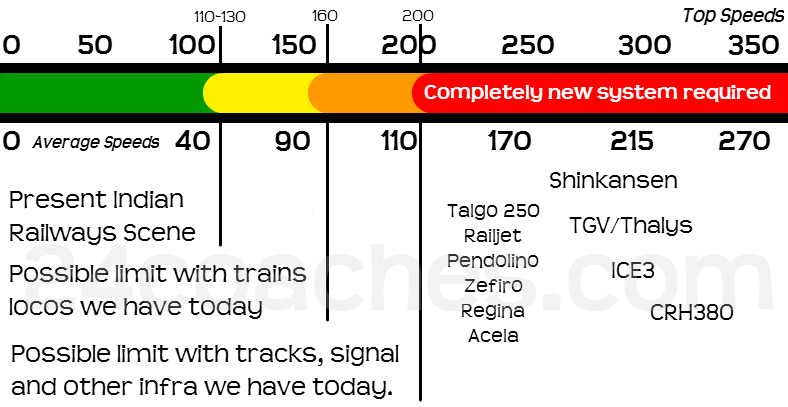
The most commonly seen ICF-coached trains, also lovingly called the blue dabbas, whose 1960-design limit their speed to 110 kph will come under the green bar above. Under the yellow come the fastest Rajdhanis, Shatabdis and Durontos whose LHB AC coaches can do max 160 kph if hauled by a WAP5 or WAP7, and are already hitting 150. Orange shows the maximum limits “conventional” tracks and signaling systems can support (not just in India but anywhere). We can achieve these speeds of 190/110 kph by acquiring modern trainsets capable of doing these speeds. Any speed above this (200+ top 120+ average speed) cannot be achieved on conventional tracks and will require new, dedicated Bullet Train-ish tracks and signalling systems to run (red). Our present trains will not be allowed to run at speeds more than 160/200 kph even if they are technologically capable of because Physics, technology and safety. Read more about this here.
There some more things to be considered here. Check the top and average speeds our present trains will be able to achieve on our tracks, ever. The maximum top/average speeds our present trains will ever, ever do is 160 kph/90 kph for the AC LHB (red) ones and 130/70 kph) for the blue dabbas. Ever. There is no way upside of that. The second and more shocking news is that with top speeds of 100-150 kph and average speeds of 40 to 90 kph (depending on the type of service, number of stops, track, terrain, traffic etc.), our trains are already nearing those top speed limits! So, it is impossible for our existing trains to do a NDLS-HWH overnight journey at 250 kph, for which entirely new train systems need to be built. And those trains will be High Speed Rail or “Bullet Trains”, called so as per international definitions.
This is when the obvious question arrives: then why not upgrade our network to the maximum permissible speed on conventional tracks (orange: 200 kph)? Wouldn’t that be easier?
A little side note: Trains running at 160 kph+ cannot have open doors and windows (Physics), so anyone hoping for our “normal” trains to run at top speeds exceeding 130+ kph (30 kph buffer for safety reasons) can throw those to the wind blowing through those little cubbyhole windows. Only fully AC trains with automatic doors can ever do speeds above 130 kph.
Upgrading Indian Railways network to support “higher” speed
Every debate about an Indian high speed railway network will come across the “Why not then upgrade our network to the maximum permissible speed on conventional tracks (200 kph)? Wouldn’t that be easier?” The answer is No. It is neither cost effective, feasible or achieves any of its objectives. This “semi high speed” is a half-baked solution that is neither here or there. Even if we attempted it, it will make no difference because of two things: track and traffic.
How much of our network should be upgrade to support this max 200 kph? All 65000 km of it? Half of it? Indian Railways classify tracks on the basis of maximum speed they (might) support (in the future). Under this, Delhi-Howrah/Mumbai/Chennai and Mumbai-Howrah are classified as Category A (160 kph) which come to around 14000 km in track length some and 30 other lines of more tens of thousands of kilometers are classified as Category B. These are the busiest and more important lines and should be the ones that need to be upgraded to 200 kph.
Upgrading the tracks will come at a massive cost
An exercise like this is not easy, simple or cheap. We need to remember that 70% of our track was built during the British Raj using the cheapest means within the technology available those days. The network was never engineered for speed but for connectivity and freight loading. Most of our permanent way never had a modern foundation as tracks were mostly laid by clearing the land to an acceptable degree of gradient and around natural obstacles or settlements. And we never really rebuilt these tracks with time. The result is that we are stuck with infrastructure designed for requirements a century past.
For these tracks to support high speeds, we will require tens of thousands of kilometers of permanent way to be rebuilt right from the foundation to modern standards. Curves have to be straightened, gradients eliminated, numerous bridges, culverts, OHE, viaduct and even tunnels (re)built; tracks, track bed, rails, sleepers, ballast etc. have to be torn out and relaid; points and crossings have to be upgraded to high-speed turnouts; all level crossings need to be closed and replaced by ROB/RUBs, all signalling has to be automated, new trainsets have to be procured and so on.
This massive engineering exercise will end up costing almost or even more than what would’ve costed to build real, dedicated high speed railway lines in money, time and effort. And what will be achieve from that? A paltry increase of 20-50 kph in top speed (5-20 kph in average speed)? And even then, trains that run on both high-speed and non-high speed lines will get only part advantage of all this. But all this is not even the real problem. This “upgraded” “semi high speed” network, will not bring any tangible improvements in speed except for a few elite trains. This is because none of this solves the real, underlying problem with the Indian Railway network: capacity.
Here is the Bhopal Shatabdi blasting past at a solid 150 kph (check the comments :))
We don’t have enough tracks
As explained in this chapter, increasing top speeds of our trains will not magically cut down travel times. Our trains are not slow because of their lack of top speeds but because they simply do not have enough tracks to run on. We have way too many trains from limited-stop Durontos to express trains stopping every 40 km to local and passenger trains that stop everywhere to super-heavy 30 kph freights crowding up our tracks, making non-stop high speed runs by a single train impossible.
Most trains in India after running non-stop for around 50 km will be forced to slow down or stop because a slow-moving train is occupying the tracks ahead. Non-stop high-speed runs by premium trains often come at the cost of many passenger, express and freight trains sided for sometimes hours to make way for them. People who travel on the Kanpur – Allahabad – Mughalsarai “Bermuda Triangle” section will understand this. Though top speeds of trains are dependent on the track, signaling, and equipment (locos, coaches, bogies etc), the time trains take to cover their total distance (and hence their average speeds) are determined by their schedules (timetables), prepared taking into account the type of track, geography, number of stops, type of stations it stops at (loop/mainline) etc and how the train should run in relation to other trains on the tracks. A WAP5 locomotive and an LHB rake alone will not guarantee continuous 160 kph runs, even if tracks support it, because there are too many trains and too few tracks for them to run on.
If we were to upgrade our tracks to 200 kph speeds, we should also ensure they are free for use by high-speed trains, which will require either building other tracks for freights, passenger and express trains to use, or building new 200 kph certified tracks for “semi” high-speed trains. Why should we spend so much money and effort to increase speeds of a small number of AC trains by around 50 kph? (non-AC trains will never go beyond 130 kph). Should we settle for a small 30-50 kph increase in speed than our current “slow” trains, or should we go for “real” high-speed trains that return 250 kph+ average (350+ top) speeds enabling 4 hour Delhi – Mumbai runs?
The Takeaways here are:
Dedicated High-Speed Rail is needed because conventional tracks and trains cannot support top speeds more than 160 (max 200) kph (90-110 kph average speeds).
Even if we “strengthen” our tracks to support 200 kph everywhere, it will not do much good because trains will still be stuck behind one another just like they are now.
All trains can run simultaneously only with “Grade separation” for fast and slow trains.
- Run all AC trains at 160 kph and non-AC trains at 130 kph max speed for ever
- Run a handful of fully Air Conditioned normal trains at 200 kph at a huge cost
- Build a high-speed train network of 300+ kph at a huge cost
How Will We Improve our Existing Network Then?
Make no mistake, the success of our high-speed rail network will on a large scale depend upon the modernization of our existing conventional rail network, as one will feed into the other. None can survive as standalone systems. So how do we achieve this? The answer to this is a question: Why should we “wait to improve” our existing network “before” building HSR? Why not do both at the same time?
The shocking fact is in reality we do not need any increase top speeds for our trains to run faster! As explained in the entire section above and in this chapter here, our trains are not really slow, they are quite fast, especially the LHB ones, as fast as any other conventional train in the world. Our trains have low average speeds only because of unavailability of track (congestion) and, train design (110 kph max speed) and poor acceleration (coached train model). People say there is no “magic wand” that will make our trains run faster. In fact, there is one. It is called “Decongestion“.
How we can build HSR and improve our train speeds at the same time
- Develop our existing railway lines to support up to 160 kph on A and 130 kph on B category lines
- Develop Dedicated Freight Corridors (already under construction) and regional and local train lines so that long-distance express trains can run unhindered by locals and goods trains
- Remove heavy loss-making and senseless populist trains from the network
- Increase capacity on all lines (doubling/quadrupling, flyovers etc)
These measures will help our trains to run at the present 110/130 kph only continuously, helping most of our trains to shave at least 10 minutes off every hour of their present timetabled travel time, or they could get 20-25% faster without increasing present top speed! This is why the current Railway Minister has made decongestion of our tracks and not introduction of new trains his primary concern. Once tracks are decongested, gradually increasing track speed capacities will help reduce traveling times and increase average speeds of trains as they will be able to run without getting struck everywhere.
Once we have both systems in place, they will give viable alternatives for all classes of passengers. High speed lines will complete a Delhi – Howrah journey from anywhere between 6 to 8 hours while conventional trains will take 14-17 hours (Delhi – Mumbai: 4 to 6 and 12-18 hours respectively) But the “improvement” of our trains does not stop there, it has to involve modernizing the visible factors of our trains as well. For this, Bullet Trains will actually help.
How Bullet Trains will Solve the Design Problems of our Trains
The major change that HSR will bring in will improve our present railway network will that our train designs will improve, which is also what the lay person means when they say that our network has to be “modernized”. To know how, let us get off the rails for some time and look at some buses. In the early 2000s, Volvo (buses) of Sweden came to India with their wonder machines and single-handedly revolutionized Indian surface transportation. Volvo introduced Indians to quality bus travel, who were until then traveling in ramshackle tin-can buses hammered together on truck chassis, and the brand became synonymous with luxury and comfort bus travel, like Xerox is for photocopies. Volvos were initially bought by private operators causing huge dents in earnings of state RTCs, forcing them too to upgrade their fleets to Volvos (Kerala SRTC was the first STU to buy Volvos), and hence bringing thier service at par or better than that of private operators – Karnataka SRTC is the best example for this. But the real change that happened was in the bus body design.
A couple of years after the Volvos were introduced, quality and design of other (normal) buses, which had been stuck in the same design rut for decades: all-metal boxy body shells of single-panels riveted together, small windows and twin-pane windshields, uncomfortable bench seats fixed on low platforms with protruding wheel arches and so on – also started improving, both interiors and exteriors, spurred on by the Volvo design. Other bus builders started taking design cues from Volvo to build their own improved models. Aerodynamic (rounded), high-platform pseudo-integral bus bodies (with molded double panels hiding all the riveting and beams), power steering, air suspension, ergonomical seats, large windows, single windshields and even that sweeping “nose” below the windshield started becoming standard features, especially so among private and tour bus operators, who wanted their buses look as close a Volvo as possible. And now they have started mimicking Scania with their vertical, rounded windshields as well. This same case can be taken for cars. As soon as the Fords, Hyundais and Skodas hit our roads, Ambassadors and Padminis became extinct, and Maruti had to innovate and improve themselves to survive.




This is all based on the theory of “forced” vs “automatic” change. Just like how the “goodness” of the Volvos spurred automatic change in the bus industry by causing other bus designs to improve, quality and comfort of high speed rail will cause automatic improvement in quality of our existing railway network. HSR will be the competition that will “improve” Indian Railways by the creation of stronger tracks, faster trains and toilets that do not stink, as it cannot be seen side by side to the shining HSR in its current decrepit state. This could be accelerated if the private sector which driven by innovation will supply modern, better and faster coaches for our traditional trains, and Indian Railways will finally stop looking like Dinosaurs. This upgrade will be automatic, as they now have an incentive to improve, because they will be dead if they don’t because if not, customers will instead of crying and shouting and tweeting and writing blogs on why Indian Railways suck, will vote with their feet: they will simply quit and take their money to the Bullet Train, leaving IR to dust and doom with its non-remunerative lower class passengers, half of who do not take tickets anyway.
Successful “automatic” system upgrades are not incremental upgrades but an entirely different system altogether. When BMTC introduced its Volvo city buses, now one of the faces of Bangalore, people said “Let us first improve the quality of existing buses first, and then buy Volvos?” What they don’t understand is that the Volvos ARE that upgrade!” Similarly, High Speed Rail IS the upgrade to Indian Railways. Did you wait for normal feature phones to get a technology upgrade to support all those fancy features or did you buy a new smartphone? Did you wait for Maruti to release a new Alto which has the features of a Swift, or did you buy a Swift? Same difference.
Now let us apply this theory of forced change to a live Indian Railways example. For around two years now we have been hearing about the much-hyped “Gatimaan Express” which will (supposedly) run at a top speed of 160 kph between Agra and Delhi (against 150 of the Shatabdi) taking 105 minutes against the Shatabdi’s 126 minutes. It still remains as elusive as the Cheshire Cat. Two increase top speed by 10 kph and save 20 minutes we have been struggling for two years and then some! The Gatimaan is an example of “forced” change, which shows us that trying to “force” our trains to run faster through “forced” upgrade of our network as per some “development plan” will not work because there is no incentive in it: no opposition to beat, no records to break, no better experience to be provided to customers, no money to be made. It is all just bureaucracy.
If we already had a 300 kph “Bullet Train running between Delhi and Agra, I would bet all my money (it isn’t much) that the Bhopal Shatabdi would’ve now been running at 200 kph top speed, because of “rub off development” incentivized by market development.
We Need to Move On!
We are already late and too far behind the curve and need to use all our available options to catch up with the rest of the world. In the 1980s, India helped Algeria build and develop their railway network. Today Algerian Railways is signing deals with European suppliers for advanced trains. India is today at that point of progression where Europe and Japan were in the 1950s and 1960s, where we have to make a decision if we have to go all out for the best or cow down and settle for sub-best. If I had my way, I would’ve skipped the entire wheeled high speed rail way and opted for Maglev trains running (flying?) at 650 kph, because by the time we finish building our HSR network, that is where the world will be. Again, it took us two years to upgrade just 190 km of our 65000 km network to 160 kph speed fit track. If we are going to work by budgets, planning, allocations etc to upgrade our entire network to even medium-semi-high-speed (160 kph), by the time we are done the rest of the world will be traveling by teleportation.
Forget everything else. The one simple reason why we shouldn’t wait for X problems to be solved before we move on to Y is because we simply cannot solve all our problems. Problems will arise constantly no matter how fast you (try to) solve them, be it for an individual or a country. Did the Japanese say “Let us solve the earthquake problem first and then build the Shinkansen?” If we are going to try and solve all our problems first and then build high speed rail, we will be stuck here only with our 50 kph average speed trains as we had been for the past whatever years. Life and civilization can advance only if we keep moving on, trying to solve troubles along the way and not by pausing and putting everything on hold trying to force change into things. One of the biggest lessons of life is that there is no such thing as an Utopia where all problems are solved and the grass is green and the girls are pretty.
There is no question that a thickly populated, on-the-move country like India with its booming economy needs a high-speed train network. Even though HSR is umpteen times more efficient, environment friendly, faster and comfortable than personal road transportation (cars, buses) or aviation, people oppose HSR as if it some conspiracy by the devil. Most of these are because are misconceptions, and in the next chapter, we will try to clear some of them.
Other Chapters on High Speed Rail
What are High Speed Railways or “Bullet Trains”?
Advantages of High Speed Railways in an Indian Context
Environmental Benefits of High Speed Rail
How HSR Will Economically Transform India

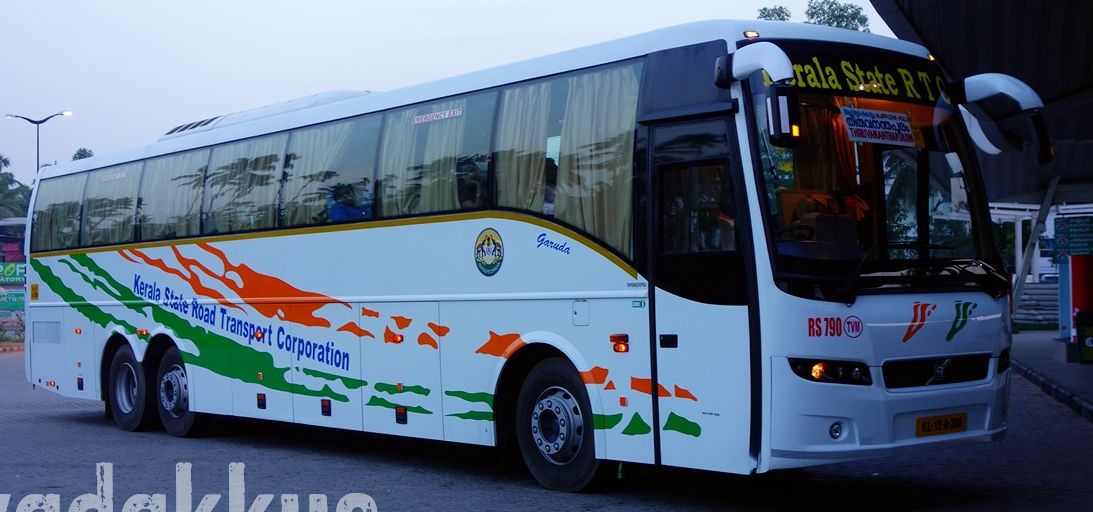
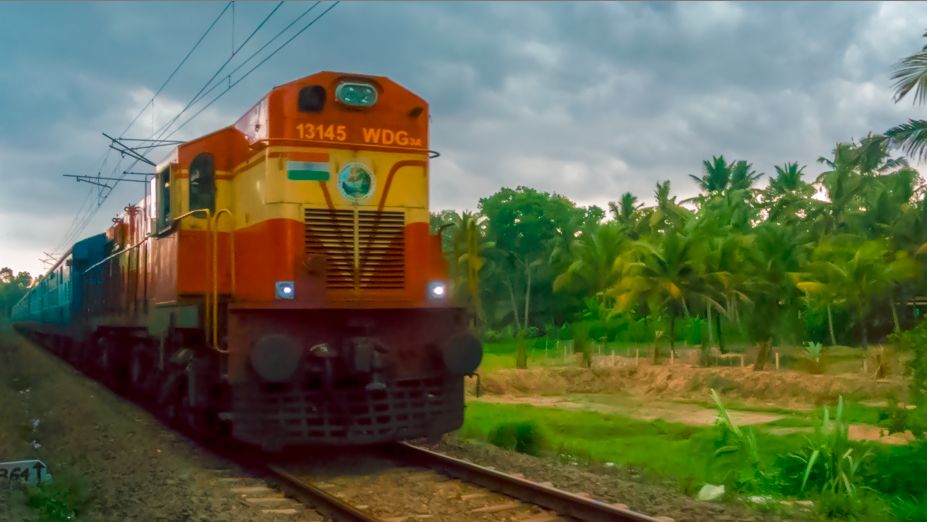
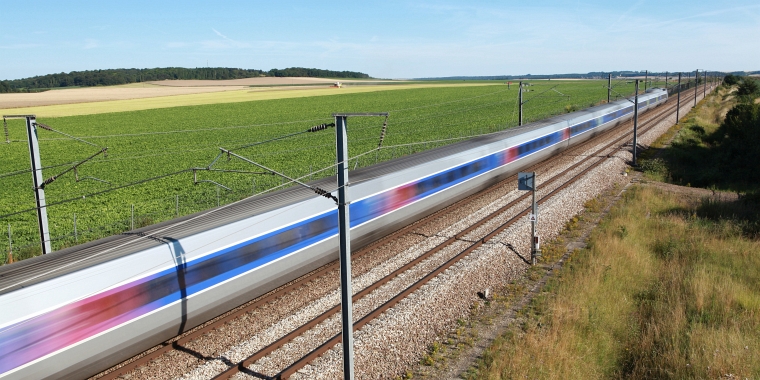

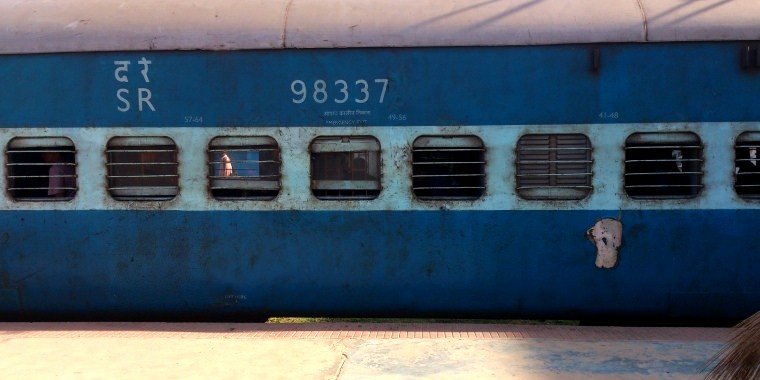
one of the best satisfying article i’ve ever read.
No doubt we need to upgrade(rather evolve). But at what cost? Why do we have to always ‘buy’? Or rely upon USA, EURO or JAPAN? I am sure big component of hefty amount of 98k crore is technology premium to JAPAN.
Had we invested fair amount in R&D, we would be in a position to set up HS infrastructure today. Stop brain drain to developed countries, where they work on hitech, later these countries sell us back at high cost. It reminds me our history lesson of British Raj which used to exploit Indian cotton industry in similar manner.
What is discussed here is pretty bullshit with none of your writers knowing anything about HSR. I bet they don’t know the difference between Bogie & coach, forget gauge, CBTC, etc. Coming back to the need of the hour your author has not studied the experience of Russia, Sweden or Spain who have upgraded their tracks and signalling and have modified HSR running at an average speed of 175- 200 kmph. Russia upgraded their 650 km long Moscow- St Peter’s-burg line at a cost of $485 million and are running their “Sapsan” high speed train on it at an average speed of 175-200 kmph, similarly the Spanish run the “Euromed” tilting trains at an average speed of 200kmph and the Swedish run their X2 trains @ 200kmph average AGAIN on upgraded track. If we were to upgrade the Delhi- Mumbai(1384 km), Mumbai-Chennai (1281 km), Chennai- Calcutta (1662 km), Calcutta- Delhi (1529 km), Delhi- Chennai (2175 km), and Mumbai- Calcutta (1968 km) routes which would form the HUB lines then the total distance for track conversion would be about 9999 km and at the same cost it took to upgrade the lines in Russia which @ Rs 66 – 1$,came to about 4.9 CR /per km, it would cost about 50,000 CR. the longest journey from Delhi to Chennai would take about 11 -12 hours and the 40 NEW rakes required would cost about 30,500 CR. So at the total cost of about 80,000 cr we would get our major network upgraded FAR LESS THAN THE Rs 98000 CR THAT THE GOVERNMENT WANTS TO SPEND ON THE 500 KM LONG MUMBAI – AHMADABAD BULLET TRAIN PROJECT.
Have to disagree with you.
The main reason trains aren’t faster in India is cause IR is a monopoly – and a government monopoly. Like all government departments they don’t have much push for improvement, add to that the passenger services are heavily subsidized, as such they don’t even have money to improve.
Make all zones independent, and get more competition and speed would increase automatically.
As for HSR, they’re bleeding everywhere. Besides with aircraft technology advancing as it is, there are few places HSR may be needed or be profitable. As a railfan – I don’t give much damn about HSR as it is.
As to comparison with Volvos – I would know something about this, on the freight side. Bus (& truck) technology was stagnant all these years because of state control over market. When Tata brought in 407, it was seen as huge leap in technology, this was 80s, and they had problems getting permissions and all.
As soon as the license-permit raj was abolished, the truck manufacturers started improving their wares. At the time when Volvo came, TATA & leyland didn’t have such offerings because there wasn’t that much of a market for them. Add to that the cost of R&D. Whilst Volvo already had those kinds of products. Now that there is a market and Indian bus manufacturers had time to develop their wares, they have comparable offerings.
One of the key issues we need to look at is adapting technology and fundamentals from bullet trains into conventional railway. There are more than a few. For instance, bullet train tracks are either very straight, or have very smooth curves. Only a few, say Delhi-Jhansi or Mumbai-Ahmedabad are full of long straight sections with minimal angles or curves- while the rest are slithering snakes. Getting high average speeds along these snake-like tracks is impossible- straightening them alone will add speed, besides building more direct connections to cut away the V-shapes, L-shapes, C-shapes and dreaded S-shapes.
Bullet trains have a very high power/weight ratio, besides having traction at multiple ends. Coached stock is mentioned as a cause of slow average speeds- I’d take that further, and say overly long coached stock hauled by a feeble 5500-6500HP locomotive. We’re seeing some traction in the trainset project every now and then. The simplest and most immediate technique to adapt is adding a second locomotive- for which, we’ll need more locomotive factories. Having locomotives at both ends adds traction and improves performance- but with electric locomotives, only one pantograph can be raised, so the coach designs will have to be altered, with power and MU control cables running across the length of each coach, and wired into the couplers. Amtrak has shorter coaches in diesel sections hauled by twin locomotives, so why can’t we?
Some bullet trains tilt along curves- while that is partly facilitated by building curved sections at an angle, units such as the Pendolino by Alstom as well as some trains by bullet train builders Hitachi/Kawasaki can tilt even along curved sections of existing lines. Adapting such trainsets to upgraded existing lines can bring high-speed comfort closer to the masses. Poland, for instance, have bucked the trend of building dedicated HSR lines, and have instead upgraded existing lines and then imported the Pendolino. Such trainsets are indeed relevant, due to the advantage they extract on legacy lines- but to get more out of those, they should resemble the Delhi-Bhopal route and not the Pune-Hubli route!
Besides this, we have the obvious advantages of improved signalling and track conditions. If we can apply what bullet trains use to our conventional railway, both sides can benefit. However, one critical aspect is pricing- we cannot afford to let bullet trains be a plaything of the rich, with plenty of idling seats. It has to be brought closer to the masses. With lengthening waiting lists in AC classes and steeply rising air fares, this is what can make a difference to them- but pricing is the key. Let’s have a section on that.